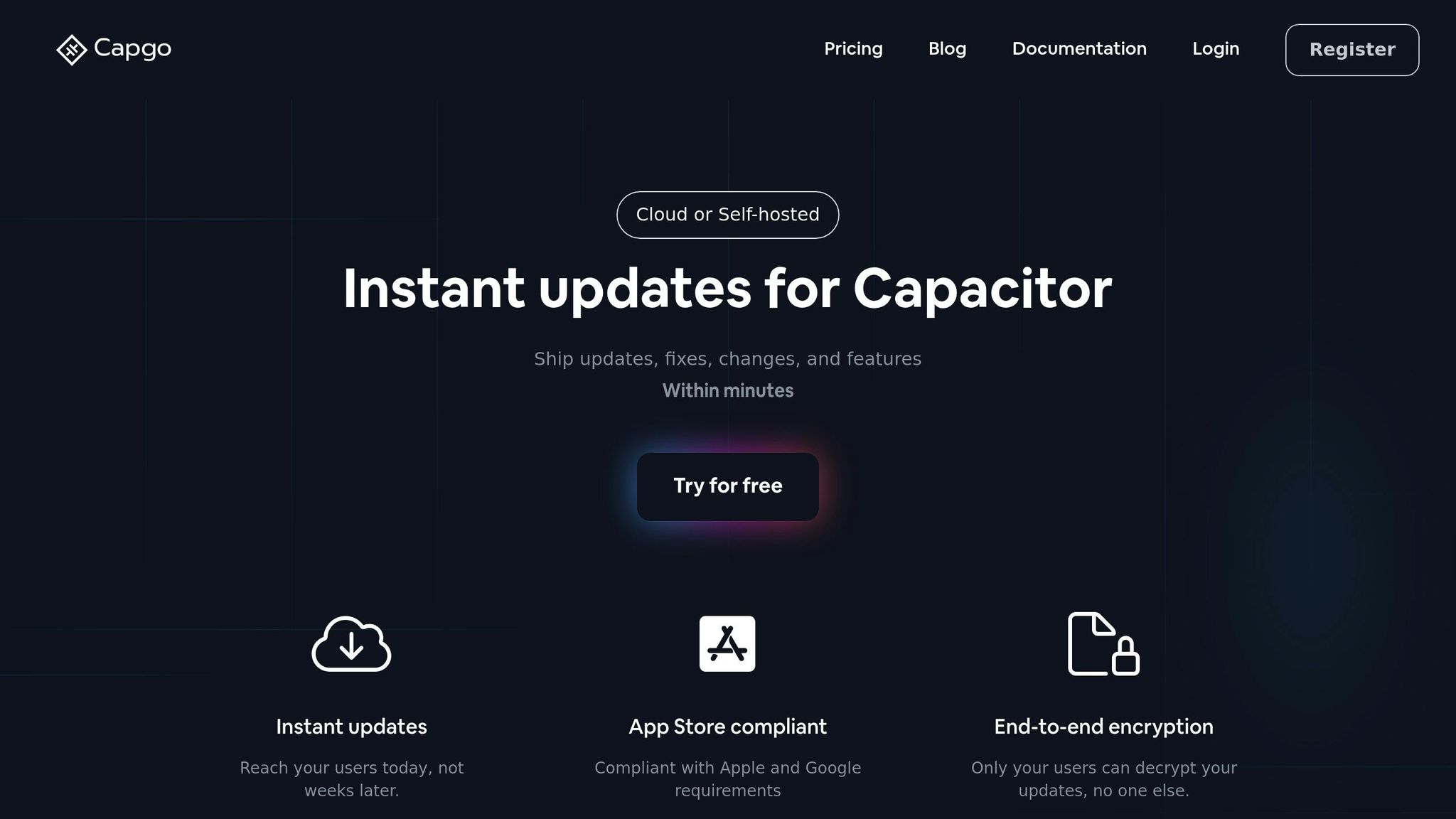The California Consumer Privacy Act (CCPA) gives users control over their personal data and sets strict rules for businesses. Here’s what you need to know to comply:
- Who Must Comply: Businesses with over $25M in revenue, data on 50,000+ users, or earning 50%+ of income from selling data.
- User Rights:
- Access: Users can request their data. Respond within 45 days.
- Deletion: Users can ask to delete their data. Respond within 45 days.
- Opt-Out: Users can stop the sale of their data. Must be immediate.
- Non-Discrimination: Equal service regardless of privacy preferences.
- Key Steps for Compliance:
- Create a secure system for data requests (web forms, email, or in-app).
- Verify user identity before processing requests.
- Use clear privacy policies and provide an easy “Do Not Sell My Personal Information” option.
- Protect data with encryption and secure storage.
Quick Tip: Use tools like Capgo for instant updates to your app’s privacy features, ensuring fast compliance with changing regulations.
How To Comply With California Consumer Privacy Act …
Understanding CCPA User Rights
Developers need to create secure and user-friendly processes to address each user data right under CCPA.
Data Access Rights
When users request access to their data, provide the following details:
| Data Category | Information to Disclose | Recommended Format |
|---|---|---|
| Data Types & Sources | Types of data collected and their sources | Machine-readable (e.g., JSON, CSV) |
| Data Usage | How the data is processed and used | Plain text summary |
| Third-Party Access | List of third parties with access to the data | Structured list |
| Retention Timeframe | How long the data is stored | Specific timeframes |
Once data access is granted, ensure you have a clear and reliable process for data deletion to stay compliant.
Data Deletion Process
- Verify the scope: Confirm that deletion covers all relevant systems, including primary databases, caches, analytics tools, third-party systems, and backups. Exceptions may apply for security, legal obligations, bug fixes, or ongoing transactions.
- Execute deletion: Remove the data from all applicable systems and notify the user immediately. Include the deletion timestamp and details of any data retained under exceptions.
After handling access and deletion rights, make sure the process for opting out of data sales is just as straightforward.
Data Sale Opt-Out
Provide an easy-to-find “Do Not Sell My Personal Information” option, accessible from the app’s main screen or settings menu. This preference should be applied quickly and remain consistent across all app versions.
If your app uses third-party analytics or advertising SDKs, ensure these services integrate with your opt-out mechanism and respect user preferences without delay. This ensures compliance and builds trust with your users.
Processing CCPA Data Requests
Here’s how to handle CCPA data requests securely while staying compliant:
Setting Up a Request System
Provide users with secure ways to submit their requests. Options include:
- A web form secured with SSL and captcha
- A dedicated privacy-focused email with an auto-response feature
- An in-app interface using a secure API
Make sure to log and timestamp every submission. Organize requests by type to streamline processing.
Verifying User Identity
Use a two-step process to confirm the user’s identity:
- First, verify their identity through their registered email or account ID.
- Then, perform a secondary check, like sending a one-time SMS code or asking security questions.
For mobile apps, you can rely on device-specific identifiers or authentication tokens for added security.
Managing Response Deadlines
Once the user’s identity is verified, stick to these steps to meet CCPA deadlines:
- Use a centralized tracker to log each request, monitor deadlines, and track progress.
- Record all details, including timestamps, verification methods, processing steps, and user communications, to ensure compliance and maintain a clear audit trail.
CCPA Compliance Guidelines
Privacy Policy Updates
Keep your privacy policy current with CCPA requirements. Clearly outline:
- The types of personal information you collect
- How you use and share this information
- User rights under CCPA
- How users can submit data requests
Write in plain, straightforward language. For example, say “according to” instead of “pursuant to.” This makes your policy easier to understand and supports your compliance efforts.
Once updated, make it simple for users to control their data, including opting out of data sharing.
Opt-Out Implementation
Include a “Do Not Sell or Share My Personal Information” option in your app. Place it where users can easily find it, such as:
- The app settings menu
- Account preferences
- A dedicated privacy controls section
Support Global Privacy Control (GPC) signals to automatically respect user privacy preferences.
| Feature | Implementation Requirement | User Experience |
|---|---|---|
| Opt-Out Button | Visible in app settings | One-tap activation |
| GPC Signal Support | Automatic detection | Background processing |
| Status Indicator | Clear toggle state | Visual confirmation |
| Preference Storage | Secure local storage | Persistent across sessions |
This opt-out process is simple and transparent, helping build trust while meeting CCPA guidelines. Pair these controls with strong security practices to safeguard user data.
Data Protection Methods
Use rigorous security measures to protect data at all stages. Encrypt all data transmissions, especially sensitive information.
For secure data storage:
- Use encrypted databases
- Employ secure key management practices
- Conduct regular security audits
- Set up automated backup systems
When deleting data, follow the steps detailed in the Data Deletion section to ensure complete removal from all systems. These methods help protect user information and maintain compliance.
Mobile App CCPA Requirements
App Permission Controls
Make it simple for users to manage their privacy settings with clear, accessible permission controls.
Consider creating a dedicated privacy settings interface that includes:
| Control Type | Implementation | User Action |
|---|---|---|
| Data Collection | Granular toggles | Enable or disable specific data types |
| Location Services | Multi-level options | Choose data precision (precise or approximate) |
| Marketing Communications | Category-based | Select preferred contact methods |
| Third-party Sharing | Individual controls | Opt out per data partner |
Place these controls in a spot that’s easy to find within your app’s settings menu. Be transparent - clearly explain what data is collected, why it’s needed, how it’s used, and who it’s shared with. This approach ensures users can quickly update their preferences whenever needed.
Using Capgo for Updates

Once you’ve established strong in-app controls, keeping your app updated is key to staying compliant. That’s where Capgo comes in. It lets you deploy updates instantly - no waiting for app store approvals. In fact, 95% of active users receive updates within 24 hours of release [1].
Here’s what Capgo offers:
- Instant Updates: Push crucial privacy and permission changes right away.
- Secure Implementation: Uses end-to-end encryption, ensuring only users can decrypt updates.
- Version Control: Roll back updates if necessary to maintain consistency.
“We practice agile development and @Capgo is mission-critical in delivering continuously to our users!” - Rodrigo Mantica [1]
Capgo’s channel system also lets you test privacy updates with specific user groups before rolling them out to everyone. Currently, 750 apps rely on Capgo in production environments [1].
Summary
Main Points
Handling CCPA data requests involves balancing user privacy rights with technical execution. Here are the main priorities developers should address:
| Requirement | Implementation |
|---|---|
| Data Request System | Secure portal with user authentication |
| Privacy Controls | Detailed permission settings |
| Data Sale Opt-Out | Clear process with user verification |
| Data Protection | End-to-end encryption |
For mobile apps, strong permission controls are essential. Capgo simplifies compliance by enabling instant updates, already supporting 750 production apps [1].
“Capgo is a must-have tool for developers who want to be more productive. Avoiding review for bug fixes is golden.” - Bessie Cooper [1]
Speed matters: 95% of users receive updates within 24 hours through Capgo [1], ensuring fast compliance with regulations.
CCPA compliance isn’t a one-time task. Regular audits and updates are necessary to keep up with changing rules and protect user privacy.




